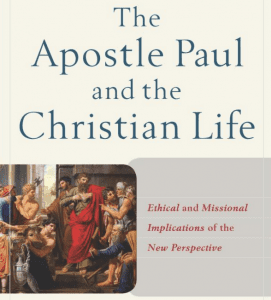 To open his chapter to The Apostle Paul and the Christian Life, Bruce Longenecker, professor at Baylor University, asks this good question, a question that is a poignant example of how the new perspective operates: “What does Paul’s engagement with first-century Jewish covenantalism have to do with Christian life in the twenty-first century?” (47). I know of no old perspective approach to the Christian life that frames the question this way. The old perspective tends reify “works” into bad and “faith” into good, and any talk of “works” in the Christian life considered not a little bit dubious if not dangerous.
To open his chapter to The Apostle Paul and the Christian Life, Bruce Longenecker, professor at Baylor University, asks this good question, a question that is a poignant example of how the new perspective operates: “What does Paul’s engagement with first-century Jewish covenantalism have to do with Christian life in the twenty-first century?” (47). I know of no old perspective approach to the Christian life that frames the question this way. The old perspective tends reify “works” into bad and “faith” into good, and any talk of “works” in the Christian life considered not a little bit dubious if not dangerous.
Longenecker observes the irony of Galatians — in 2:16 and 3:2, 5, and 10, Paul contrasts faith and works but in 5:6 what matters is “faith working practically through love” (his translation). Ah, he says, works from two angles, one wrong and one right.
At times, Paul’s contribution to Christian theology has been conceived simply in terms of establishing that Christians are free from having to do anything since they enjoy eternal salvation in the heavenly world of perfect glory by means of their faith in Christ. But Paul did not expect the Christian to live a life devoid of “good works. He did not think that Christian activity jeopardizes the eternal destiny of the “soul.” Doing good is not, in fact, foreign to Paul’s view of the Christian life. As we will see, Christian activity is an essential component of Paul’s theologizing about God’s engagement with the world (48).
So Ephesians 2:8-10 is the perfect balance: not by works but created to do good works. The issue is not works or no works, but works of the Torah vs. faith works. What does “faith works” look like?
To live is Christ, acc to Phil 1:21, and largely the same is found in Romans 6. They die to become alive in him and they die for him to become alive in them! (49). What does it look like? It looks like Jesus Christ who comes alive in the Christian. But,
Performing Jesus Christ requires the transformation of moral character, which itself flows from the character-forming influence of the Spirit (51). Or again, when describing his own apostleship, Paul writes the following in 1 Corinthians 15:10: “By the grace of God I am what I am, and his grace toward me has not been in vain. On the contrary, I worked harder than any of them—though it was not I, but the grace of God that is with me.” In Paul’s theologizing about the Christian life, textbook mathematics and commonsense causality are thrown out the window (52). [And this:] For Paul, then, the self-giving of Christians flows from the cruciform self-giving of the Son of God, who gave himself for others.7 In fact, Paul understands self-giving love to be the embodiment and advertisement of the power of God, who, through Christ, is overcoming the chaos that lurks in the crevasses of creation and who is restoring right relationships at every level of the created order (53).
If Christ-shaped life is the positive, the opposite is a community shaped by covetousness. Hence, Galatians 5:20-21. At this point Longenecker enters into territory more centrally present in the apocalyptic school of thought: covetousness brings to expression the cosmic powers, the stoicheia that distort and destroy.
All leading to a multi-ethnic and diverse worship of God the Father in Christ through the Spirit. From p. 61:
In this light, we can see that Paul’s concerns for corporate unity and healthy relationships among disparate identities arise not so much from matters of “social ethics” or “corporate identity” or “ecclesiology” but primarily from matters of theocentric worship (61).
To us, the word love might sound like emotional sentimentality; bearing burdens might sound like a pastoral nicety; becoming slaves to one another might sound like a metaphorical platitude. For Paul, however, these were part of the arsenal in a cosmic battle against dysfunctional forces that collude to corrupt and corrode a world that God is reclaiming through Christ, to his praise and glory (62).
So, what is the problem with “works of the Torah”?
The answer must be somewhere along the following lines: because Paul perceived the moral configuration of the gospel to lie at the christological axis of self-giving, he saw the attempt to force gentiles to be circumcised a form of opposition to the moral configuration at the heart of the Christian gospel precisely because be saw it as an unhealthy form of “centrism” It represented the attempt by certain Christians to promote their own cherished identity over other forms of legitimate identity (66).
Supersessionistic? Hardly:
The only thing to note for our present purposes is how the story of the self-giving Jesus absorbs the potentially damaging centrism of some forms of Torah observance and metamorphoses it into healthy self-giving, in which the Torah ironically finds its true fulfillment (68-69).











